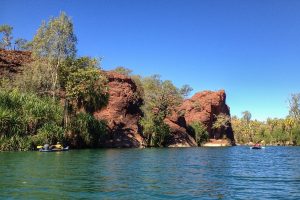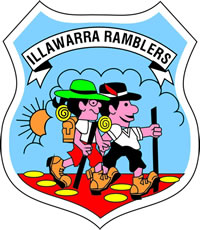Participants: Caryll Sefton (leader), Denis Riley (support), Bert and Diana Hazelton (Illawarra Ramblers), Peter Tomkins (NPA).
The problem with the trip pointed out to me before we left was that there would be no water as Queensland is in the middle of a dreadful drought. This I blissfully ignored. The main problem with Western Queensland is it is so far away and the roads are not good. This I knew before we left. Overall we travelled 8,500km in four weeks.
The rivers of Western Queensland drain three ways, into the Lake Eyre Basin, the Darling River and the Gulf. We sampled these three river systems at twelve locations on natural waterholes, upstream from weirs and dams and on flowing rivers. Paddling on the rivers which flow into the Lake Eyre Basin and the Darling River is like paddling on a caramel milkshake and entering and exiting (mainly) where there is no boat ramp is through deep slippery, thick, dark mud.
To appreciate what we did on the trip it is necessary to understand the river systems of Western Queensland. The rivers flow after local rain or intense rain in the tropics and instead of one channel, flow in a series of braided channels. The channel country provides excellent feed for fattening cattle and being Queensland, the best in the world.
The major tributaries to the lake Eyre Basin are the Diamantina River and Cooper Creek which rise in NW Queensland. On the Diamantina River we paddled a permanent waterhole at Hunters Gorge in Diamantina NP. The waterhole is the result of the choking of the river as it flows through the Davenport Range when in flood. At Longreach the Thomson River is backed up behind a complex of weirs blocking channels. These channels provide an excellent paddle. The Thomson joins the Barcoo River (paddled at Isisford, Oma waterhole) above Windorah to become Cooper Creek. Cooper Creek was in flood after two dumps of rain and flowing over a weir at Windorah. Another excellent paddle. East of the Lake Eyre Basin are the southerly flowing rivers of the Darling River System. These also form channels. At Eulo a low weir blocks a beautiful section of the Paroo River which was also flowing after the recent rain. We paddled upstream against the current to explore two channels.
The Warrego another river blocked behind a weir at Cunnamulla has a channel which was explored but was choked with a South American weed that sadly an echidna had drowned in as it got caught up in the weed infestation on a side channel. The first two rivers we paddled were the Balonne River (Surat) and the Barwon River (Goondiwindi). Both were flowing over weirs prior to the rain.
Finally the rivers of the north which flow into the Gulf. The waters of Lawn Hill Creek and Gregory River originate from springs in the karst system to the south and are both perennial. It is a furphy that they rise from sub terrain water from New Guinea. Lawn Hill Creek flows through what must be the most beautiful gorge in the world in Boodjamulla NP. It is just too beautiful and always reminds me of a Hollywood Movie Set. The sky is blue, the gorge is red, the vegetation is green and the water is crystal clear (no caramel milkshake here) and turquoise. The Gregory River is a wonderful flowing river of clear water which twists and turns at a magnificent rate through Pandanus and provides lots of spills and thrills. The final river paddled in the north was Lake Julius a major dam on the Leichardt River which is in red mountain ranges and rivals the beauty of our own Lake Yurunga on the Shoalhaven River.
The vegetation of the rivers varies from the tropical Pandanus and palms of the north, and the Coolibah and beautiful River Red Gums of the south. Birds may be prolific or occasional and the most delightful was the fly catcher who flew around us relieving us of flies at Diamantina Lakes NP.

Kangaroos are common and expensive. Road kill where they are not cleaned up is about one kangaroo every 50 metres. Pigs, foxes, raptors and cattle were also frequent, but not cats. The only cats we saw were alive and well.
The towns of Western Queensland have many points of interest and they have developed a comprehensive museum and information system covering all aspects of the region; natural history, dinosaurs, mineralogy, industrial history (the shearers strike), transport history (Cobb and Co), and support systems for those who live in isolated communities (School of the Air and Flying Doctor).
I would like to thank Denis who made the trip possible and Pete who was always an invaluable willing helper. Caryll Sefton
